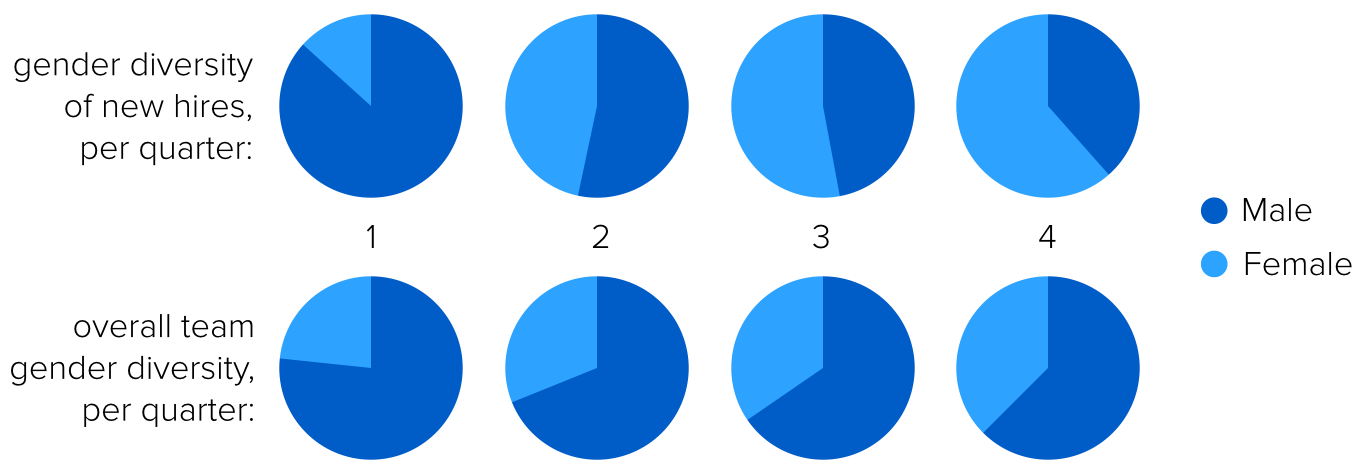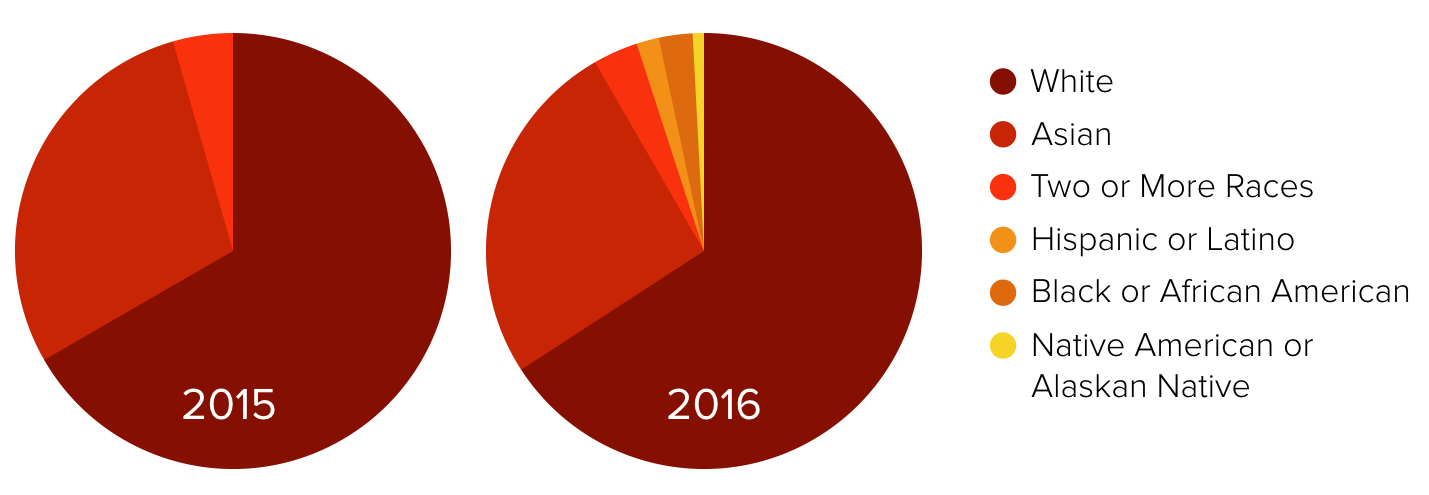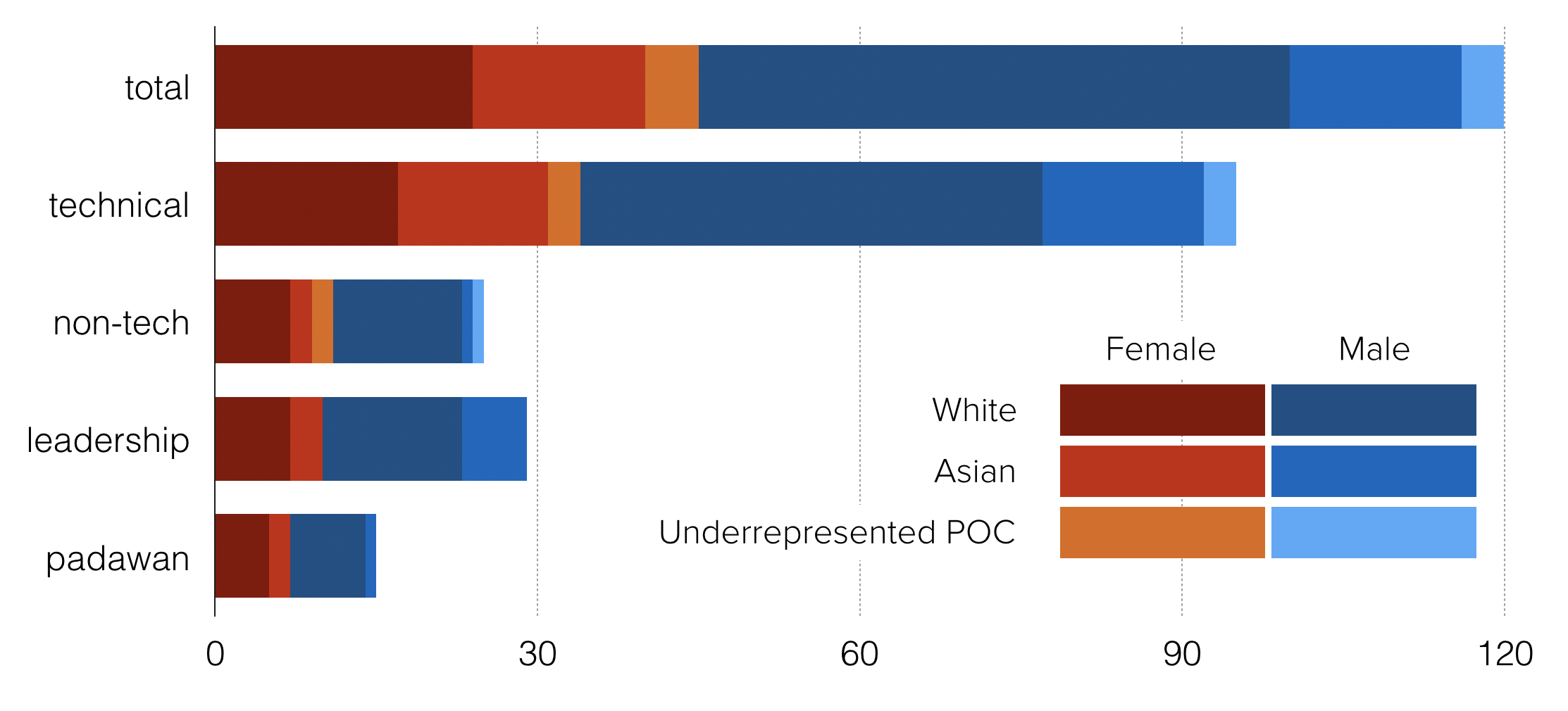A lot of tech companies have issues with diversity. We don’t want to be like other tech companies.
There are countless studies that show that diverse teams perform better, that workplaces that are inclusive and welcoming of people of all genders, races, ages, abilities, and orientations are more productive and engaged, and that companies with more diverse leadership make more money. Fostering a diverse and inclusive environment is also just the right thing to do, and something that I’ve cared deeply about for a long time.
2016 was a year of incredible growth for our team—in the past 12 months we’ve nearly tripled in size. As we started to ramp up our hiring in the second half of 2015, however, we noticed a disturbing trend. Our gender ratio, which had long hovered around 27% women (not a great starting point to begin with), was beginning to fall. In the second half of 2015, we hired only 23% women.
We quickly recognized that if we continued to ignore diversity and kept along this trajectory, we would rapidly cement a skewed gender ratio that would make a lasting impact on our team and culture. The more we looked into it, the more we realized that early in a company’s growth is the right time to address diversity because it’s much easier to address diversity as a small team, where a small number of hires can make a large impact on percentages. Not to mention that it would really suck to someday succeed at our mission to make biology easier to engineer but then wake up and realize we built just another technology company full of white dudes.
We also recognized how hard it is to make positive changes when it comes to diversity and inclusion in tech. Many companies make promises in good faith to improve diversity but fail to yield any subsequent quantifiable improvements. So we made the decision to focus specifically on reversing our gender diversity numbers in 2016 because we wanted to not just pay lip service to diversity but actually make meaningful change. It was a difficult decision but we felt an initial focus on one axis of diversity was important to increase our likelihood of success.
Around the same time as these Ginkgo team discussions on diversity were happening, Barry and I happened to watch the movie Moneyball. Moneyball tells the story of Billy Beane and the 2002 Oakland Athletics baseball team. Faced with a very limited budget, Billy Beane had to figure out how to put together a winning baseball team. To do so, he relies on sabermetrics to identify very good players that are undervalued by the typical criteria used by other teams. The A’s go on to have a record-breaking 20 game winning streak during the 2002 season. (In fact, the Sox use a similar approach to break the Curse of the Bambino and win the 2004 World Series).
In watching this movie, it was very apparent to me that the driving theme of the sabermetrics approach is to look for talent that is being systematically undervalued by the competition. As almost any study will tell you, women and underrepresented minorities hold fewer positions and make less money in our industry than other demographic groups. Since I believe that these female and minority candidates are every bit as smart and talented as their counterparts in other demographic groups, by definition this means that women and underrepresented minorities are being systematically undervalued in the marketplace. Thus if we can make Ginkgo a place that these folks want to be (say by identifying and addressing our own biases, creating an inclusive culture, and providing fair, equal pay), then we can create a competitive edge in attracting talent from these demographic groups. To be very clear, in our case this isn’t about fielding a team for less money or paying anybody less—it’s about hiring great people who are being unfairly passed over by other companies. As every startup knows, recruiting and retaining great talent is one of the key challenges that any startup faces. Suddenly our commitment to diversity became not just about doing the right thing but also about creating a sustained competitive advantage for Ginkgo.
We still have a long way to go, but I want to share our statistics from 2016. Please note that these data are based on the Federal Equal Employment Opportunity reporting categories and are imperfect representations of the spectrum of diversity. Nevertheless, I think they paint a promising and optimistic picture about how our team is growing.
The first set of graphs below shows the change in gender diversity during 2016. The top line shows the relative percentage of men and women among new hires in each quarter. In the first quarter of 2016, even after we had begun discussing issues of diversity, our hires were only 13% women. This was extremely disappointing and made us redouble our efforts.
The second quarter of 2016 saw our biggest jump in hires, with 30 new people joining, 46.7% of whom were women. Now at the end of 2016, we are so pleased to see that it wasn’t a statistical fluke and that we’ve kept our gender diversity up for new hires in each quarter since then, up to 61.5% in the last three months, for a total of 44% during all of 2016.

All together, this is slowly making an impact on our overall gender diversity. We started the year with 27% women, which dipped down to 23% by the end of the first quarter of 2016. At the time of this writing, we’ve reached 37.5% women and are headed in the right direction. Breaking it down further, the trend is generally upward across the company’s different teams and across levels, from interns to senior leadership (see third graph, below).
We’re encouraged by these statistics but we’re far from declaring success. We’re committed to expanding our efforts in 2017, to keep that upward trend until we reach 50% and to consider other aspects of diversity including age, sexual orientation, race, ethnicity, national origin, and educational background, among others. Here’s where we’re starting 2017: the graph below shows data for racial and ethnic diversity at Ginkgo at the end of 2015 vs. the end of 2016. We started the year with a team that was 67% White, 29% Asian, and 4% two or more races. By the end of 2016, our diversity was broader, but still heavily skewed—66% White, 26% Asian, 3% two or more races, 2% Hispanic or Latino, 3% Black or African American, and 1% Native American or Alaskan Native. We have a lot more work to do here next year.

And finally, here is where we start 2017 looking at race and gender together for the team as a whole, for technical vs. non technical position (non-technical is defined as management, business development, marketing, and operations, most of whom have a strong technical background), leadership (founders, managers, team leads, and program leads), and padawans, our one-year paid interns. The numbers are still relatively small so it’s difficult to draw too much from these overall, but I’m pleased to see that our ratio of women in technical (35.8%) and leadership positions (34.5%) is close to our overall percentage (37.5%). Moving forward, it’s also important to track the many intersecting forces that have kept women and minorities excluded from technology fields over time.

So what did we do to reverse the trend on gender diversity? How did we make such a dramatic difference so quickly? We started by talking. We held open discussions where team members could candidly discuss issues of diversity and inclusion that were important to them. Importantly, our leadership attended those meetings and made a strong commitment to hiring and retaining a diverse team.
After those first meetings we started to pursue a range of concrete strategies, particularly:
-
- look beyond and expand our own networks to focus on actively recruiting from more diverse pools
- take a close look at and rewrite our job postings to be more inclusive
- make sure for each opening to bring in a diverse set of people for on site interviews
- work towards a culture of inclusivity that makes Ginkgo an awesome place to work for everyone
- continually check in to see how we’re doing and to keep diversity and inclusion an active project for all of us
We’re always challenging ourselves to raise the bar and build the best team to achieve our mission to make biology easier to engineer. We hope to do even better in 2017.
